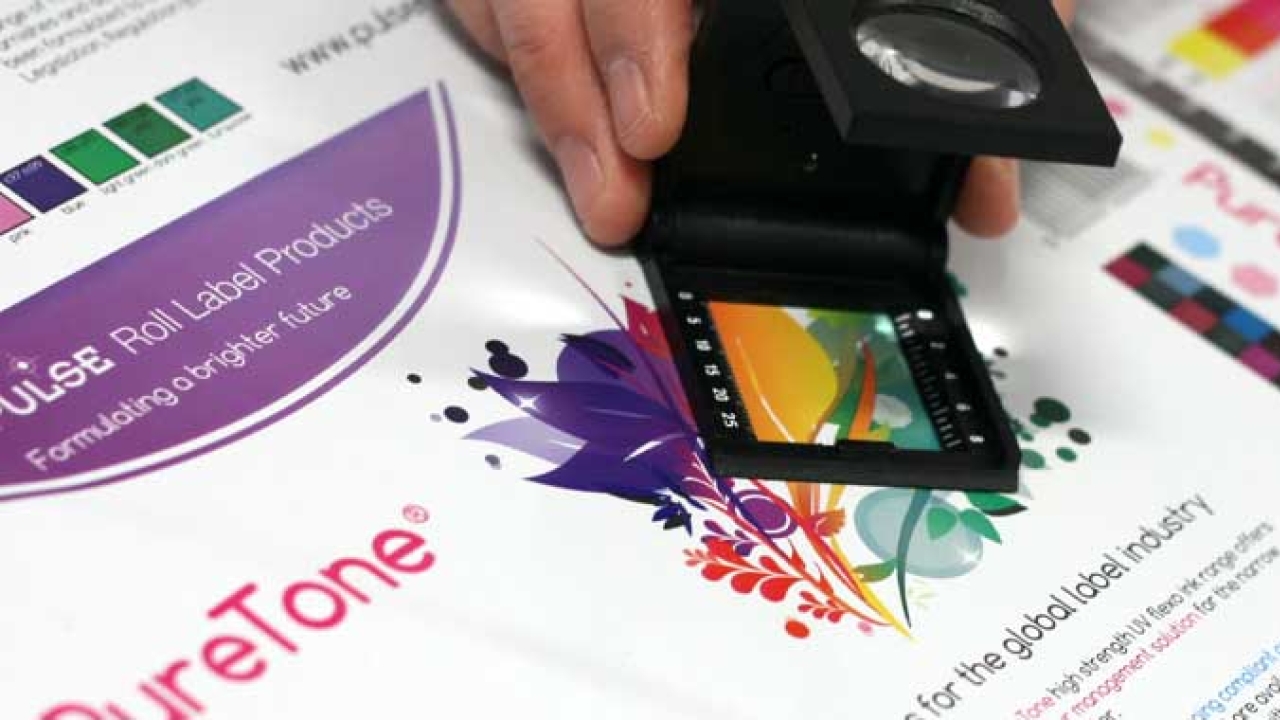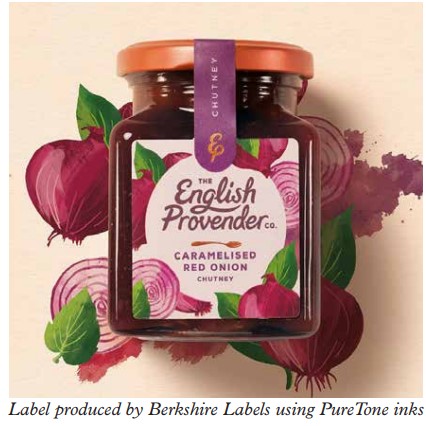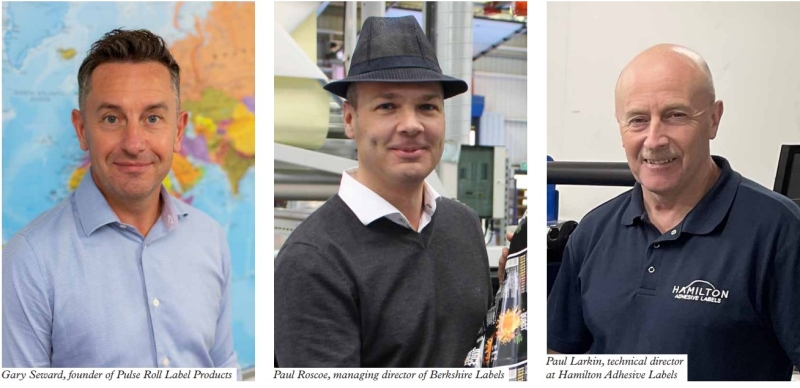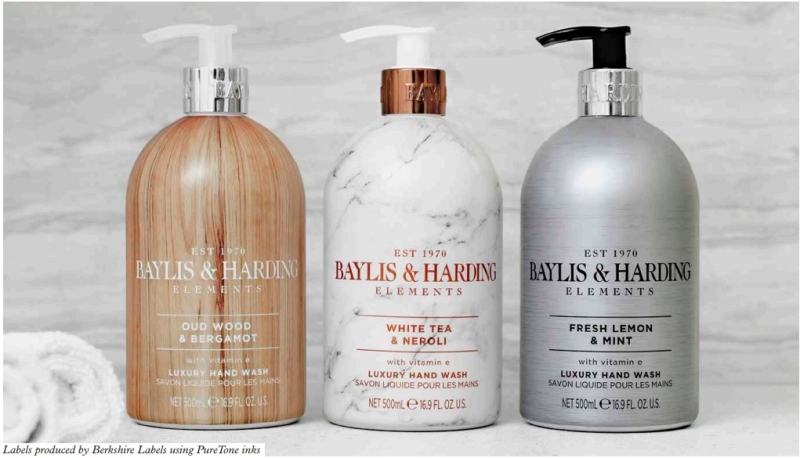Standardizing color
Ink mixing and matching are one of the most time-consuming processes on the production floor. If not done correctly, it leads to waste of materials, makeready time and, most importantly, press time. But what if the ink and color matching process could be standardized to hit the right color on the first attempt?

It is always a useful exercise to see how a new technology works in practice some years after it was launched – whether it matched the marketing claims made at the time. In this article we look at Pulse Roll Label Products’ PureTone flexo system, launched on the first day of Labelexpo Europe 2015 with the claim it would revolutionize color matching on flexo presses. How has this worked out in practice?
PureTone is a high strength, mono-pigmented flexo ink mixing system, which comprises nine base colors with the addition of a special Royal blue plus extender. The single pigment formulation of the nine mixing bases makes it easier to color match due to the reduced total number of pigments used in the mixed ink. This enables optimized color strength and cleaner colors to be achieved and also reduces the potential for metamerism, says the manufacturer.
The high strength formulation allows for lower film weights of ink resulting in reduced inventory and lower ink volume consumption for narrow web printers and provides greater flexibility for printing half-tones and full-tones using one printing plate.
Gary Seward, founder of Pulse Roll Label Products, first came across ink standardization issues when working as a plant technician mixing inks early in his career. ‘It was not with flexo ink then, it was with silk screening but it’s the same principle. The same problem occurs when you choose a silkscreen mesh or an anilox. Variability is what causes the problem. Printers would come back to me and say
that the colors are wrong when in fact I made the correct shade. And it was very clear that the printers were making their own decisions on what screens to use to print with – the same with the anilox.’
Seward developed a procedure with the converter’s pre-press division to ensure that the right screen volumes were used with the right inks. The press operators then knew which screen to use with what ink. ‘My problems went from up to 20 a day to probably two a week. All because I made the inks for the same screen every time.’
Seward concluded that leaving the choice of what anilox or screen to use for spot colors with the printer was the main problem. The press remains idle while the converter chooses the anilox, assesses its availability, mixes and matches the ink and runs print tests to get the right color and consistency.

PureTone was developed to take human judgment out of ink color matching. Pulse developed a database of 11 base colors that the system would use to create the right color automatically. Seward claims that on average 30 percent less ink is used with PureTone than with a standard 18-base Pantone mixing system.
‘The database is so accurate, anybody could use it. I could teach you to color match – even if you have not touched ink in your life – in about 15 minutes,’ he says.
The second key element was to take the choice of anilox away from the printer. The only way was to provide them with one standard anilox to use with the PureTone inks for spot colors.
Pulse Roll demonstrated that every Pantone color can be achieved using a 5-6 volume anilox, providing the PureTone database is calibrated to that anilox. A converter would simply have to ensure an
inventory of the same volume anilox across all presses.
‘Now the printer doesn’t need to make the fundamental choice. It is made for him by us because we are the ink manufacturers, we know how strong the inks are.’
Seward says the advantages of using a standard volume anilox for all spot colors include greater consistency, a high color strength for lower film weight, better adhesion, improved halftone reproduction, less wastage and better cure.
That was the thinking behind the PureTone ink mixing system. How did it work in practice? L&L spoke with three label converters in the UK who have switched to PureTone inks.
The database is so accurate, anybody could use it. I could teach you to color match – even if you have not touched ink in your life – in Label produced by Berkshire Labels using PureTone inks about 15 minutes
Reflex Labels
The Reflex Group claims to be the UK’s largest label converter. The company has several production sites across the UK and is in the process of setting up new sites overseas. In December 2021 the converter added Macfarlane Labels of Kilmarnock, and its subsidiary companies, Macfarlane Group Ireland and Macfarlane Group Sweden, to the group.
Ian Kendall, CEO, says Reflex Labels was already using Pulse products when PureTone was being developed.
‘I’ll be quite honest with you, when people say: “We’ve got this really good product and you will use less ink volume", I’m always a bit skeptical,’ Kendall says. But when Reflex Labels implemented the
PureTone system, it found that the inks performed as expected and this was backed up by the data.
The production process all the way from pre-press was adjusted around PureTone, says Kendall. ‘Once you have optimized each element of the process, you can get a job on press much quicker, with less makeready time, and less set-up is required to match the color you need – that’s another thing that we’re really hot on.’
Apart from the ink volume and cost savings, PureTone is a food compliant low migration product as well, which ticks all the boxes for Reflex in terms of UV inks.
Kendall says that PureTone has made the operator’s job easier since there is no more manual selection of anilox or mixing inks. ‘It’s printing by numbers, so as long as you do it right, it is a lot easier to get the right result. So actually it makes the printer’s life easier. But you do need other skills in reprographics before it gets to the press.’

Reflex Labels is currently running PureTone on 50 presses and will gradually roll it out to the McFarlane operations.
‘When we acquire a company like we did with Mcfarlane, we are moving over in a steady and sensible manner to using PureTone. And because of the way it works, you have got your analysis and can already determine pretty accurately how much less ink by volume we’re going to use as a business, which is good. So Puretone is a win from all perspectives such as cost saving, environmental benefit and reduction in the amount of product being transported around the country.’
Hamilton Adhesives Labels
Hamilton Adhesive Labels has been operating in the UK label industry for more than 25 years covering multi-color to plain labels. The PureTone ink system was integral to the company’s strategy to achieve predictable print results.
Paul Larkin, technical director at Hamilton Adhesive Labels, began working in the industry 47 years ago, a time when flexo was ‘not even a print process recognized by the union in the UK’. He had worked with rotary letterpress and litho and saw huge potential for flexo when anilox rolls were invented.
Larkin has focused on developing a predictive system for flexo that is accurate the first time. Quality and efficiency are by-products of the system. ‘However, the difficulty was that the ink industry never
understood the benefit of the “common quality”,’ he explains.
‘What do I mean by a “common quality”? Typically, the pigment strength if ink changes dramatically depending on what color you print. For example, a Reflex Blue may need a 9.0 volume anilox to achieve color where a Warm Red may only require 6.0 volume. The impact of this on quality and downtime is significant.
Once you have optimized each element of the process, you can get a job on press much quicker
The aim was to identify if an ink company could achieve sufficient color using an 800lpi x 6.0 volume anilox against any color in the Pantone book. The benefits would be huge If this could be achieved
without compromise including: perfect solids, vignettes and fine type in the same plate; reduction in ink costs; reduction in downtime.
Continues Larkin: ‘The issues with traditional ink gets compounded when multiple inks are mixed together. Predictive software does its best, however a wide range of anilox rolls are required to cope.
Printers typically have to make multiple changes before achieving a commercially acceptable result. You are essentially engineering waste into the system straight away.’
Larkin initially tested the PureTone system using a datum point anilox roll, this allows for an exacting starting point on all presses. Pulse passed with flying colors in rheology, viscosity, cure, gloss, flow,
accuracy and hitting the common quality volume, he says.
It took Larkin about a year to set PureTone up and by the end of the process had defined plates, inks and anilox rollers best suited to the system. Hamilton invested in a new laboratory and equipment
and spent a few months testing and calibrating the laboratory to the presses and specified anilox inventory. Today the converter’s facility is equipped with multiple machines set up in exactly the same way.
‘Everything marries into this measurement and control philosophy to make a predictive system where quality is the by-product of the system,’ explains Larkin. ‘You can only have a predictive system if there is a high level of control in every single part. If the ink system is fundamentally flawed where you take ink right out of the tub and it ranges from 5-10 volume, you haven’t got a predictive system.’
In the five years the converter has been using PureTone, Hamilton has perfected its ink estimating formula and has achieved around a 25 percent improvement in overall efficiency.
‘When it comes to using more ink to achieve sufficient color, it has a negative impact on the print, and no one has put those two together except Pulse. Gary has a strong printing background,’ Larkin adds.
Berkshire Labels
Berkshire Label has been in the label business for nearly 40 years. The company expects to make a turnover around 14 million GBP (17.2 million USD) this year and employs 75-80 people.
It prints labels both flexo and digital, with the latter making up 40 percent of its revenue. The company specializes in self-adhesive labels, sticker sheets, shrink sleeves, wraparound reel-fed labels and pouches for markets as diverse as food and beverage, nutraceutical, vitamin supplements, toiletries, healthcare, cosmetics, security and horticultural.
Six years ago, Berkshire invested in its first full servo-driven flexo press, a 17in Mark Andy Performance series machine. ‘We had spent a lot of time on digital investment. And it was now time to take our digital experience, know-how and mindset and apply it into flexo,’ says Paul Roscoe, managing director of Berkshire Labels.
‘We have lots of customers that we look after that start off in with sample runs and short runs and then they build into a nice sized business. Some of them remain on digital, but we want to be able switch them to flexo for the longer runs. So we don’t mind whether we do 1,000 or a million labels, the customers gets the same good experience from Berkshire and doesn’t have to care how it is produced.’

The Mark Andy flexo press was installed along with a GMG color management system to generate certified proofs for customer artwork. Berkshire took Pulse’s four-color ink system and made sure it hit the ICC profile to match the proof. Digital Pantone and IQC (Incoming Quality Control) systems were also implemented.
And then it came down to spot colors. Up to that point, the converter would mix Pantone colors then adjust them to reach the target color. Roscoe wanted to save time on the process and standardize it.
Pulse introduced PureTone to Berkshire and demonstrated how the inks hit the Pantone colors first time and achieve Delta E tolerance of 2 or below. Pulse also promised that by scanning a spot color, previous color or customer swatch, the system would provide the color spectrum and matching ink formulation.
‘The days of us mixing and matching were behind us when we put this system in,’ Roscoe notes.
Berkshire could now promise customers with confidence that jobs produced in either flexo or digital would achieve Delta E tolerance of 2 or below, although in practice most jobs the company produces are below Delta E of 1.
The days of us mixing and matching were behind us when we put this system in
Berkshire invested in a standard medium volume anilox inventory, profiled the presses and set up the PureTone ink system across its three 17-inch wide Mark Andy servo presses.
‘We love customers coming down. We love to show them what we do. But at the same time, we question why they’re coming. They’re coming to make sure we hit the color,’ Roscoe says.
Along with PureTone, Berkshire added GMG proofing and the X-Rite IFS software which works with the PureTone library.
‘It has worked very well and we have saved lots of time. We have taken questions and opinions out – it either hits the color or it doesn’t. And then it’s just a question of maintaining the system, putting the controls in place and ensuring repeatability,’ Roscoe explains.
Berkshire Label’s flexo investment has not only been in a new press, but a fully ‘digitized’ flexo ecosystem.
‘We couldn’t spend all this money on a flexo press for it to be stood waiting for components, ancillaries and inks to be ready and available. So for us it was a question of keeping the press moving. We don’t want to be mixing and matching on press. We also don’t want to be mixing and matching many times and making lots of variants. Puretone just gave us the Pantone color that we hit the first time,’ says Roscoe.
Pulse installed the system and trained Berkshire’s pre-press team and supported the converter in the first few weeks to ensure everything was done correctly. ‘And it’s been successful sailing since. It is quite a simple system to understand. They give you a guaranteed set of ink and formulas, and you make the ink and it matches. As long as you don’t change anything, it always matches,’ Roscoe says.
With the new system and presses in place, Roscoe estimates the company has saved 2-3 hours a day previously spent mixing inks in the six years since switching to PureTone.
Stay up to date
Subscribe to the free Label News newsletter and receive the latest content every week. We'll never share your email address.


